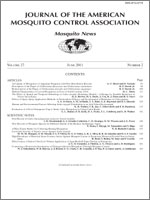Efficacy of fenitrothion as thermal fogging (TF) or ultra-low volume (ULV) applications against 6 successive generations of caged adult Culex pipiens and subsequent development of resistance in both adults and larvae were investigated in this study. In addition, larval acetylcholinesterase (AChE) activity was measured in each generation. Results indicated that the ULV application method was significantly more effective (P < 0.05) than TF against the adults in all treated generations. Selection pressure of TF and ULV applications on the adults after 5 generations resulted in larval resistance by ratios of 30.92- and 28.18-fold, respectively. A gradual decrease in the larval AChE activity was observed with increasing resistance as generations progressed. The AChE activity of susceptible larvae was higher than that of the F5 resistant generation in TF and ULV treatments by 6- and 8-fold, respectively. The results indicated that both the biological efficacy of fenitrothion and the rapidity of resistance development were affected by the application methods.
How to translate text using browser tools
1 June 2011
Effects of Space Spray Application Methods on Fenitrothion Efficacy and Development of Resistance in Culex pipiens
Ali S. Al-Sarar,
Abdulwahab M. Al-Hafiz,
Yasser Abo Bakr,
Alaa E. Bayoumi,
Hamdi I. Hussein
ACCESS THE FULL ARTICLE
It is not available for individual sale.
This article is only available to subscribers.
It is not available for individual sale.
It is not available for individual sale.
Culex pipiens
fenitrothion
resistance
Thermal fogging
ultra-low volume





